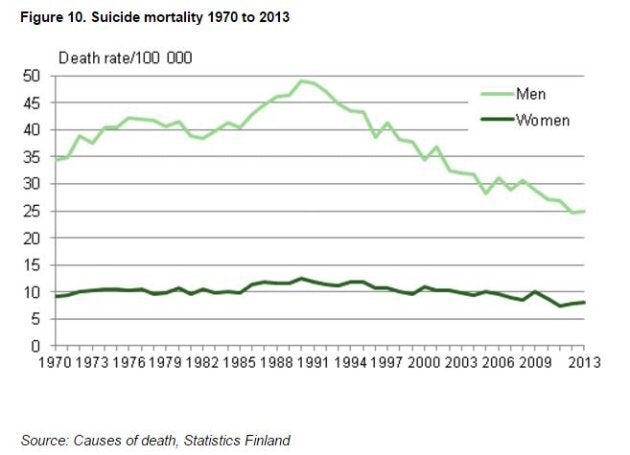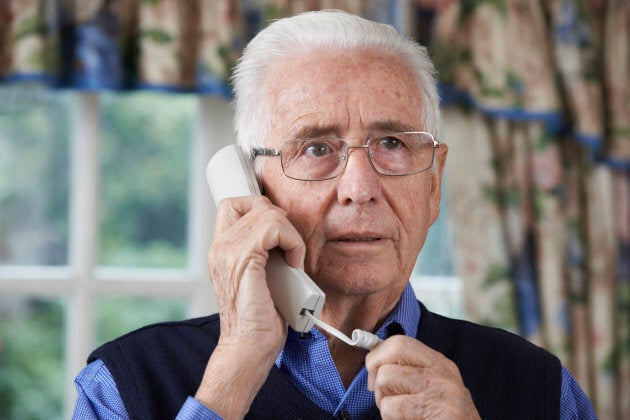
The statistics on suicide are grim.
As of March this year, depression is the leading cause of disability and ill health worldwide, the World Health Organisation (WHO) announced.
Around one million people end their own lives each year. In Lithuania -- which has the highest suicide rate in the world -- around one out of every 2,000 citizens commit suicide every year.
The Shocking Statistics
- Worldwide, over one million people end their own lives each year -- that's one person every 40 seconds
- A further 10 million attempt suicide annually
- The suicide rate has risen around 60 per cent in the last 45 years
- Lithuania has the highest suicide rate in the world, with around one out of every 2,000 citizens killing themselves every year
- Suicide is the leading cause of death in young people in many nations, including Australia
- The majority of people do not receive psychiatric help before taking their own lives
And the problem is getting worse, not better; globally, suicide rates have increased 60 percent in the past 45 years. Suicide prevention strategies are under-researched, under-funded and often lack cohesive strategies. Meanwhile, the stigma around mental illness still prevents many people from seeking help. In the face of these seemingly insurmountable obstacles, it would be easy to dismiss suicide -- and the blight of mental illness that can be the root cause -- as an inevitable fact of modern living.
But there is hope. With targeted programs, government funding and community support, individual nations have managed to counter the global trend and reduce suicide rates. Individual programs to build community cohesion, address the stigma and help people access support have saved lives.
Thirty years ago, facing a suicide epidemic among its young men, Finland became the first country in the world to tackle the problem at the national level. Three years later in 1990, male suicide levels peaked at 49.3 per 100,000 people -- that's one in every 2,040 people ending their own lives each year -- and have been steadily falling ever since.
The male suicide rate in Finland was 21.4 deaths per 100,000 at last count -- still relatively high compared to other OECD nations, but a far cry from the 1990 rate that would have been the second highest in the world by today's numbers.

So what did Finland do that so drastically turned around the nation's rising rate of male suicide?
The first thing to note is that it was not simple, or quick.
It was a top-down approach, implemented gradually over more than a decade. Working with the support of government bodies, project coordinators developed programs across all sectors of the community, encompassing schools, Defence Force workers, churches, welfare organisations and, importantly, health care workers and first responders.
One important aspect of the approach was a crisis management program implemented in Finnish schools. Principals, teachers, welfare workers and school psychologists were all trained on how to respond in a crisis situation, such as the suicide or attempted suicide of a student or parent of a student, and a 'crisis working model' was rolled out across schools.
After undertaking the program, not only did schools report being better able to respond in a crisis; they also noted a greater willingness amongst staff to discuss painful issues -- a key part of breaking down the stigma and creating environments where people feel able to seek help.
Similarly to other nations, for every suicide in Finland each year, there are another 10 people who attempt it. This means that providing better care to those who have tried to take their own life is a key part of reducing suicide rates.
While hospitals are often dominated by the elderly, over half of those attempting suicide in Finland are under 35. In the 1990s, Finland began to move mental health services away from hospital-based care towards treating people in the community and at health care centres. Follow-up care was also increased and communication between the person involved, their relatives and the health care workers was improved.
There are many things that may cause someone to attempt suicide. In times of increased political tension, economic uncertainty or cultural upheaval, suicide rates often rise, while in more prosperous and peaceful times they will fall.
Nevertheless, Finland's male suicide rate has declined year-on-year for the past 27 years. Less than half the number of people are dying by suicide in the Nordic state now than in 1990. This is an indicator of just what can be achieved when there is a sincere national commitment to tackling the problem which results in real-world programs and genuine reform.
The World Health Organisation (WHO) supports Finland's approach. In its inaugural suicide report, Preventing Suicide: A Global Imperative, WHO stresses the importance of a national suicide prevention strategy to "indicate a government's clear commitment to dealing with the issue".
This strategy should encompass surveillance, means restriction (for example, blocking off access to bridges and high rooftops), guidelines on media reporting on suicide, stigma reduction and raising of public awareness, as well as training for health workers, educators, police and other gatekeepers.
While a standout case, Finland is not alone in finding effective ways to reduce the suicide rate. Twenty-eight nations worldwide now have national suicide prevention strategies, and a further 13 are developing them.
Here are some examples of specific programs around the world that we can learn from.

Suicide is the leading cause of death among young people in many nations around the world, including Australia. Schools are unique in being able to access the vast majority of teenagers at a key time during their social and physiological development, meaning that they offer great potential for suicide reduction programs.
Youth Aware of Mental Health (YAM) is a program developed by Swedish and American scientists for 14 to 17-year-olds. The five-session program works primarily through role plays, which are chosen and enacted by the teenagers.
The YAM program covers six main themes: increasing awareness of mental health; self-help advice; dealing with stress and what to do in a crisis; depression and suicidal thoughts; helping friends in trouble; and where to go for advice.
According to the researchers behind the program, "in YAM, youth are considered experts of their own mental health and their voices and experiences take centre stage".
The role plays and group discussions "help youth to explore problem solving and encourages solidarity and how they can help peers in need".
The program also connects the young people to local health sources in their community, making them more aware of where they can turn for help.
In an independent study comparing three youth suicide prevention programs in 168 schools across Europe, YAM was found to be by far the most effective in reducing both suicide attempts and suicidal thoughts.
For every 167 students who completed the program, one suicide attempt was prevented. Furthermore, the number of students experiencing suicidal thoughts halved.
"The design of the YAM, aimed at changing pupils' negative perceptions and improving their coping skills in the management of adverse life events and stressors... could account for its significant effects," the SEYLE (Saving and Empowering Young Lives in Europe) researchers concluded.
The fact that YAM actively involved the students, encouraging them to express their thoughts around mental health issues, was also significant according to the researchers, "because people showing suicidal behaviour tend to suppress their emotions and have difficulties in identifying their feelings".
It is also notable that, in the SEYLE study, no change in the teens was noticed at three months, but significant changes were observable one year on. This demonstrates the need, as with the Finnish Project, for long-term planning and support in order to effect real change.
The program is now being introduced in schools in New South Wales, while the Black Dog Institute's Chief Scientist, Helen Christensen, is calling for the program to be put in place in all schools across Australia.
One advantage of YAM is its fluid approach, which means that it is able to cross national and cultural barriers -- something which many other prevention programs struggle to do.
It should come as no surprise that those serving in the military are at a higher risk of experiencing mental illness and suicide than the general population.
Members of the military who experience combat exposure are three times more likely to develop PTSD -- a known risk factor for suicide attempts, even decades after returning from battle -- a study published by the U.S. National Center for Biotechnology Information showed.

In the early 1990s, the suicide rate in the United States Air Force rose rapidly, with 15.8 deaths per 100,000 by 1995.
Senior officials in the U.S. Air Force believed suicide "represented the end of a long road of personal suffering in which multiple indicators of vulnerability pointed to the need for help".
In 1996, a program was implemented that saw the suicide rate among active personnel drastically reduce, falling to about six deaths per 100,000 by 2002.
Key to the program's success was addressing the stigma around mental illness within the male-dominated organisation, which in 2017 is still 80 percent male. Four times as many men die by suicide in the United States than women -- a fact which alone is enough to make the Air Force an at-risk group.
Another major reason behind the program's success was that the Air Force began detecting those at risk of suicide -- and providing them with the help they needed -- much earlier on.
Eleven initiatives were implemented. These included formal training on suicide prevention for all military personnel. Commanders were taught to recognise early warning signs and encourage those affected to seek help. The emotional state of anyone in the air force who was arrested or subjected to investigation was closely monitored, and trauma stress response teams were set up around the world to help in the case of traumatic incidents such as terrorist attacks, serious accidents, or suicide.
Importantly, air force leaders were actively involved at all levels, and were key in encouraging a more accepting culture amongst military personnel.
A WHO report into the program points out that as well as reducing suicide, the program also saw a significant drop in rates of violence towards others, with rates of both homicide and severe family violence declining by more than 50 percent.
The evident success of the U.S. Air Force program shows that it is possible to drastically reduce suicide rates, even for very high-risk groups such as those exposed to trauma and violence. It also indicates the importance of targeting programs to the unique challenges of specific communities rather than taking a cookie-cutter approach.
Elderly people are often overlooked in discussions on suicide, yet older men in particular are a high risk group.
In Australia, men over 85 actually have the highest risk of suicide out of any age group, with 39.3 deaths per 100,000 people (by comparison, the suicide rate for 20 to 24-year-old men is 22.5 per 100,000). Elderly people are more likely to be dealing with physical disability and social isolation and are less likely to access support services (such as a telephone helpline or online group) in times of crisis.
In Italy, which has a low overall suicide rate of 5.4 per 100,000, the older generations make up a high proportion of deaths by suicide.
To address this, a two-part telephone help service was established in Veneto, in northern Italy.
The first service, called Tele-Help, was an alarm that the client could activate in order to call for help at any time. The second, Tele-Check, involved a twice-weekly phone call to assess the at-risk person's needs and provide emotional support.

A review from 1988 to 1998 found that, simply by providing people with an easily accessible place to turn for help, the service was able to significantly reduce the number of suicides. The suicide rate was three and a half times lower for the 18,641 people who used the service over the decade, compared to other elderly Italians in the same period.
"Although the elderly seldom use hotline services, the design of the service effectively made the intervention proactive and interactive," a WHO report into the Italian program observed.
"Tele-Help/Tele-Check service appears to provide support of great interest for the prevention of suicide in the elderly, of which results can be maintained in the long-term."
As modern societies become increasingly isolated and the proportion of people living alone continues to rise, it is becoming harder to make sure no one is cut off from accessing support. Older populations are less likely to own a computer or have access to the internet. Simple strategies like this one offer an achievable way of keeping them connected and able to access help in times of crisis.
The success of individual projects like these is encouraging. It shows that real people on the ground can make a difference: building emotional resilience and coping skills in vulnerable teenagers, connecting the elderly with access to around-the-clock support, addressing the stigma of mental illness in male-dominated industries.
What these programs show above all is that human contact is key. The most successful programs were those that connected people more to one another and to support services -- whether that was through a buzzer, role playing, counselling or a training program.
Moreover, the Finnish Project shows what can be achieved when there is a genuine commitment to change at a national level. Successive governments, health workers, community outreach groups and the general population were able to create more supportive communities, reduce the stigma and help people of all ages create coping skills to see them through life's challenges.
Lifeline is exploring Australia's suicide emergency with business and community leaders. The #StopSuicideSummit was held on May 1 in partnership with HuffPost Australia and Twitter.
If you need help in a crisis, call Lifeline on 13 11 14. For further information about depression contact beyondblue on 1300224636 or talk to your GP, local health professional or someone you trust.
ALSO ON HUFFPOST AUSTRALIA